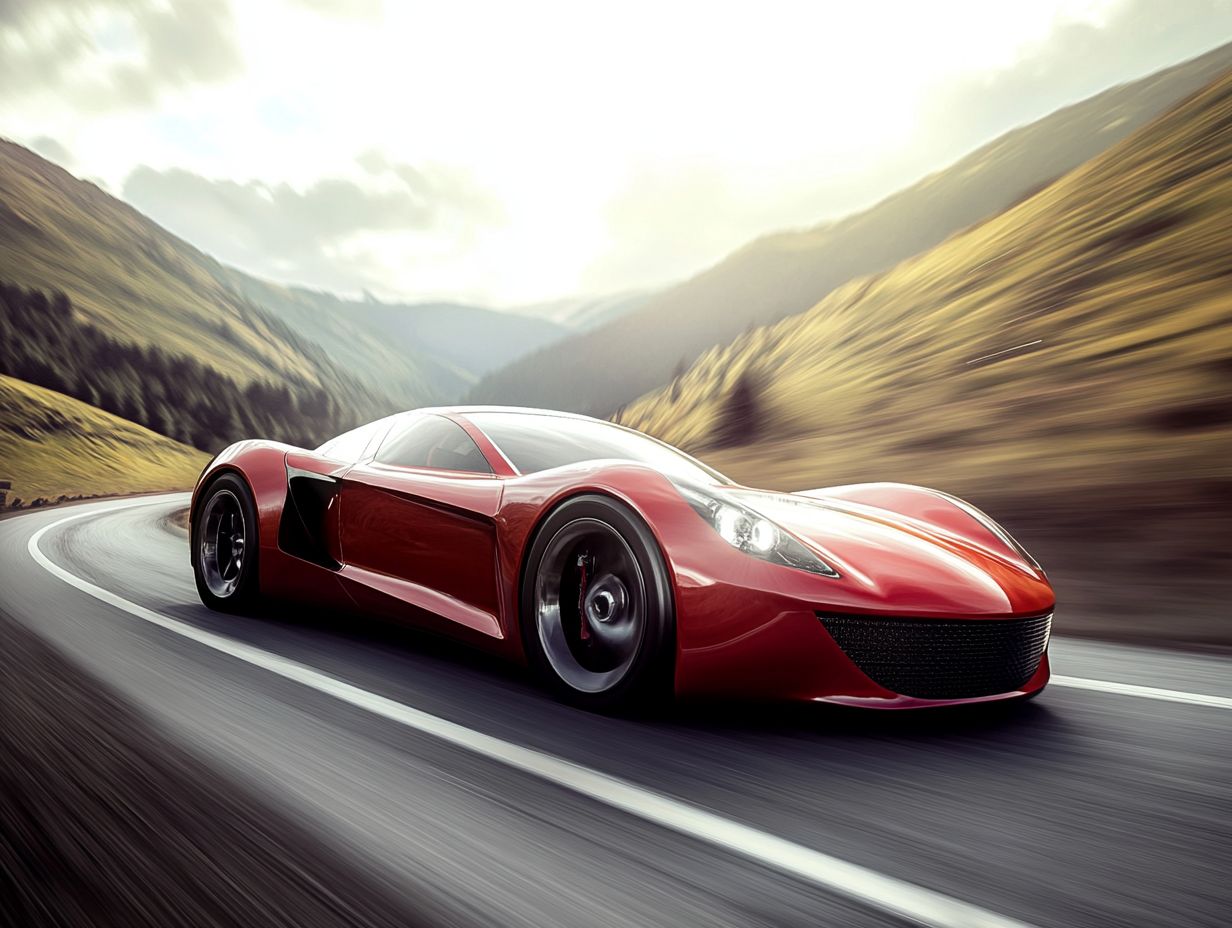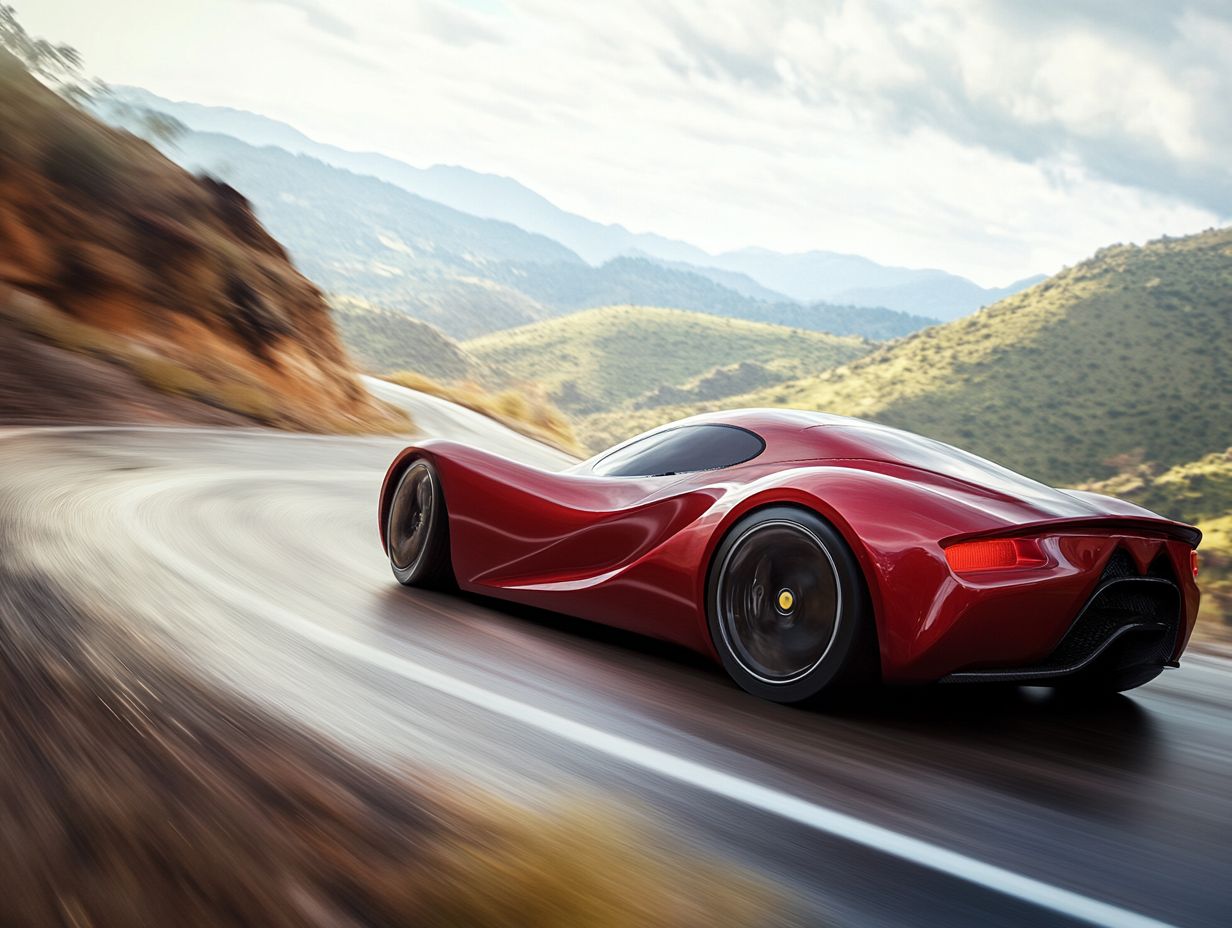Best Performance Features in Sports Cars
Sports cars embody the essence of speed, agility, and state-of-the-art technology. But what really distinguishes them from ordinary vehicles?
Dive into the premier performance features that transform these machines into exhilarating driving experiences. From robust engines and lightweight designs to sophisticated suspension systems and high-performance tires, discover the innovations that refine both performance and handling.
Embark on this journey as you uncover how these features elevate the driving experience, exploring their benefits and impact on overall efficiency.
Contents
- Key Takeaways:
- 1. Powerful Engines
- 2. Lightweight Construction
- 3. Aerodynamic Design
- 4. Advanced Suspension Systems
- 5. High-Performance Tires
- 6. Efficient Braking Systems
- 7. Enhanced Steering and Handling
- 8. Sport-Tuned Exhaust Systems
- 9. Advanced Transmission Options
- 10. Launch Control
- 11. Variable Valve Timing
- 12. Turbocharging and Supercharging
- 13. All-Wheel Drive
- 14. Performance Driving Modes
- 15. Carbon Fiber Components
- What Makes a Sports Car Different from Other Cars?
- Frequently Asked Questions
- What are the best performance features to look for in a sports car?
- How does a powerful engine enhance the performance of a sports car?
- Why is a lightweight body important for a sports car’s performance?
- What role does an advanced suspension system play in a sports car’s performance?
- How does aerodynamic design contribute to the performance of a sports car?
- Are high-performance tires necessary for a sports car?
Key Takeaways:

- Sports cars are equipped with powerful engines, lightweight construction, and aerodynamic design, making them capable of achieving high speeds and quick acceleration.
- The advanced suspension systems, high-performance tires, and efficient brakes improve sports cars’ handling and control, allowing for a more thrilling driving experience.
- Features like launch control, variable valve timing, and all-wheel drive provide sports cars with superior performance and agility, but may also impact fuel efficiency and emissions.
1. Powerful Engines
Powerful engines are the essence of high-performance cars. Iconic models like the Chevrolet Corvette, Porsche 911, and Ferrari F12 Berlinetta exemplify this blend of power and speed.
These machines fuse power and speed to deliver an exhilarating experience on both the road and the track. Each engine is not just a remarkable feat of engineering; it embodies the cultural significance of performance cars, showcasing innovation and sustainability through advanced technologies and hybrid powertrains.
Among the various engine types, V8 engines are known for their powerful performance and unique sound, like those in the Dodge Challenger.
This model offers thrilling acceleration that delivers a truly visceral driving experience.
V10 engines, while less common, offer a delightful mix of high-revving performance and torque that appeals to enthusiasts chasing that adrenaline rush.
Meanwhile, hybrid configurations, like those in the Tesla Model S Plaid, are redefining what horsepower means, providing instantaneous torque and remarkable efficiency.
These amazing engine types boost performance and make every drive an unforgettable thrill!
2. Lightweight Construction
Lightweight construction is crucial in performance cars, utilizing materials like carbon fiber to enhance agility and speed while minimizing overall weight.
This smart reduction in weight means you enjoy better fuel efficiency what a win for both performance and the planet!
Take the Ferrari SF90 Stradale, for instance; it exemplifies how innovative engineering, combined with advanced lightweight materials, elevates both power and handling.
Similarly, the Lamborghini Sian FKP 37 showcases a hybrid design that employs carbon-fiber-reinforced plastic, significantly enhancing its performance metrics.
By minimizing weight without compromising structural integrity, these vehicles achieve higher acceleration rates and demonstrate a remarkable reduction in emissions, setting new benchmarks in the automotive industry.
3. Aerodynamic Design
Aerodynamic design plays a pivotal role in the efficiency and performance of high-speed sports cars. Experience models like the Porsche Taycan Turbo S and Aston Martin Valhalla achieving breathtaking top speeds while maintaining stability.
These vehicles are meticulously crafted with features such as spoilers, diffusers, and sleek lines, all working in perfect harmony to minimize drag and optimize airflow.
While traditional sports cars may battle with wind resistance, the innovative designs of these models allow you to glide effortlessly, enhancing both speed and handling.
When you compare them to less aerodynamically refined alternatives, like conventional sedans or older supercars, the difference is striking. Improved aerodynamic elements not only elevate performance but also significantly enhance fuel efficiency, granting you the freedom to enjoy exhilarating rides without the constant need for fuel stops.
4. Advanced Suspension Systems
Advanced suspension systems are essential for maximizing handling and ride comfort in performance cars. They allow you to experience the exhilarating grip and stability of models like the Audi RS6 Avant and Lexus LC 500h, even during the most aggressive maneuvers.
These sophisticated systems, such as adaptive suspension and air suspension, play a pivotal role in fine-tuning your vehicle s dynamics. These systems adjust to suit various driving conditions, enhancing your experience.
Adaptive suspension reacts in real-time, responding seamlessly to road irregularities and your driving style. You will instantly feel the enhanced comfort during your daily commutes while still benefiting from razor-sharp handling on twisty roads.
Air suspension lets you adjust your vehicle’s ride height. You can optimize performance whether speeding down the highway or tackling off-road trails.
Together, these technologies elevate your driving experience. They enable you to push your car to its limits, ensuring that every corner is conquered with confidence and precision.
5. High-Performance Tires
High-performance tires are a must-have for sports cars. They deliver the grip and stability that elevate both performance and safety at exhilarating speeds.
These specialized tires are crafted for a variety of driving conditions. For instance, summer performance tires prioritize traction in warm weather.
These tires usually use a softer rubber compound that excels on dry roads. Their tread patterns are engineered for optimal stability during tight corners.
In contrast, track tires are specifically designed for the racetrack. They provide outstanding handling and responsiveness in extreme conditions.
Renowned brands like Michelin, Pirelli, and Bridgestone push the envelope with innovative designs that cater to those who crave the ultimate driving experience.
Choosing the right tire composition significantly impacts your car’s handling dynamics. It’s essential to select the perfect option tailored to your performance needs.
6. Efficient Braking Systems
Efficient braking systems are absolutely essential in high-performance cars. They allow models like the Chevrolet Camaro ZL1 and Ford Mustang Shelby GT500 to stop on a dime, even at exhilarating speeds.
These systems utilize advanced technologies, including carbon-ceramic brakes. These brakes are made from lightweight materials that resist heat.
For you, as a driver pushing your vehicle to the limits, this means enhanced performance without compromising safety.
Anti-lock braking systems (ABS) are designed to prevent wheel lock-up during hard braking. This design allows for better control and stability.
These innovations boost stopping power and give you the confidence to tackle sharp corners and sudden deceleration.
Ultimately, the synergy of these braking technologies is crucial for both safety and optimal performance. They elevate your driving experience to unparalleled heights.
7. Enhanced Steering and Handling

Enhanced steering and handling are vital elements that shape your driving experience in performance cars. They deliver the control and precision you expect from high-caliber vehicles like the Rimac C Two Concept and Acura NSX.
These improvements are powered by sophisticated technologies, such as electric power steering and adaptive steering systems. These systems enhance the feedback you receive and adjust to changing driving conditions.
For example, the Rimac C Two Concept offers a razor-sharp response perfectly aligned with its electric powertrain. The Acura NSX features its unique calibration, striking a balance between agility and comfort.
These innovations grant you individualized handling characteristics. You can intuitively connect with the road and elevate your overall performance experience.
When you compare these systems to those in other sports cars, you ll find each model adds its own distinct flavor. This ultimately influences how you engage with the vehicle on both the track and the open road.
8. Sport-Tuned Exhaust Systems
Sport-tuned exhaust systems do more than just amplify the sound of performance cars; they also enhance engine performance. This transformation turns vehicles like those from Dodge and Chrysler into truly exhilarating driving experiences.
These systems are carefully engineered to reduce back pressure the resistance to exhaust flow and to optimize gas flow. This results in more efficient combustion and a significant boost in power output. Features such as active exhaust valves allow the vehicle to adjust its sound based on different driving conditions.
For example, while cruising calmly on the highway, these valves produce a more refined tone. However, during aggressive acceleration, they unleash a deeper, roaring sound that intensifies your driving experience.
This blend of performance and auditory thrill fulfills the enthusiast’s craving for power, deepening your emotional connection to the vehicle. Every drive can be nothing short of memorable.
9. Advanced Transmission Options
Advanced transmission options like dual-clutch and continuously variable transmissions (CVTs) are essential for the performance of modern sports cars. They allow you to experience the exhilarating acceleration of models like the Tesla Roadster.
These technologies enhance gear shifts and optimize power delivery. This provides you with seamless acceleration that elevates your control over the vehicle. They fine-tune the engine’s output based on driving conditions to maximize fuel efficiency while ensuring peak performance.
In luxury vehicles and high-performance coupes, advanced transmissions redefine your interaction with the road. This results in a dynamic driving experience that balances speed and responsiveness, making every drive exceptional.
10. Launch Control
Launch control systems are expertly crafted to optimize acceleration from a standstill in high-performance cars. They enable you to unleash the full potential of your vehicle, whether it’s a Porsche 911 or a Lamborghini Sian FKP 37.
These sophisticated systems manage engine power, traction control, and sometimes even adjustable suspension settings to guarantee maximum grip at takeoff. By calibrating the engine’s torque output and managing wheel slip, launch control minimizes the risk of losing traction, resulting in faster acceleration times compared to traditional methods.
This means not only a quicker getaway but also a more stable driving experience. Your vehicle remains predictable, enhancing overall driving dynamics and ensuring that every race or track day is thrilling and unforgettable!
11. Variable Valve Timing
Variable valve timing is a cutting-edge technology found in top-tier performance cars. It enhances engine efficiency and power delivery, which is essential for high-performance models like the Ferrari F12 Berlinetta.
This mechanism adjusts the timing of the engine’s valves, smoothly responding to different engine speeds. By fine-tuning the valve events based on RPM, this technology ensures that the air-fuel mixture is used to its fullest potential.
The result is an engine that offers exceptional torque at low RPMs while providing a thrilling increase in horsepower at higher speeds. This versatility enhances throttle response and improves fuel efficiency key for any performance-oriented vehicle.
By achieving the ideal balance between power and economy, variable valve timing stands out as an essential feature that elevates your modern driving experience. Explore more about how these advancements can transform your driving!
12. Turbocharging and Supercharging
Turbocharging and supercharging are game-changing technologies that significantly boost engine power without increasing size. These technologies are essential in high-performance vehicles like the Audi E-tron GT and Tesla Model S Plaid.
Turbocharging uses exhaust gases to spin a turbine, compressing incoming air for a denser mixture. On the other hand, supercharging draws power directly from the engine s crankshaft, providing immediate throttle response.
Turbocharging offers benefits like improved fuel economy and reduced emissions. Meanwhile, supercharging is known for its instant power delivery.
For example, the Ford Mustang EcoBoost demonstrates the advantages of turbocharging, while the Mercedes-Benz AMG lineup showcases the benefits of supercharging. These technologies are pivotal in modern automotive engineering.
13. All-Wheel Drive
All-wheel drive systems improve traction and handling in performance cars, giving you an edge in various driving conditions, similar to the Audi RS6 Avant.
These systems distribute power to all four wheels, enhancing stability and control, especially on wet or uneven surfaces. Whether navigating winding mountain roads or slippery city streets, you ll feel more confident behind the wheel.
Take the Subaru WRX STI, famous for its rally heritage; it benefits greatly from all-wheel drive, allowing you to accelerate with authority in challenging conditions. Vehicles like the BMW M340i blend performance with practicality, making everyday drives exhilarating.
14. Performance Driving Modes

Performance driving modes let you customize your vehicle’s dynamics and responsiveness, enhancing your driving experience in models like the Lexus LC 500h and Chevrolet Corvette Stingray Electric.
These modes cater to various driving styles, each affecting your car’s handling, suspension, and throttle response. For instance, track mode tightens the suspension, improving cornering and reducing body roll on race tracks.
Conversely, comfort mode provides a smooth ride by absorbing road bumps, making long drives more enjoyable.
This versatility allows both enthusiasts and casual drivers to connect with their vehicles in different conditions, enriching the overall performance experience.
15. Carbon Fiber Components
Carbon fiber components are synonymous with lightweight construction in high-performance vehicles. They help you reduce weight while improving both strength and aesthetics.
You ll find this innovative material used not just in external body panels, but also in interior elements like dashboard trims and seat frames. By choosing carbon fiber over traditional materials, manufacturers achieve an impressive balance between durability and minimal weight, affecting your vehicle’s acceleration, handling, and fuel efficiency.
The reduced weight allows engines to run more efficiently, leading to lower fuel consumption and emissions. Plus, the sleek appearance of carbon fiber brings a modern touch to your ride, appealing to those who appreciate a blend of performance and style.
Ready to experience the power of these technologies? Discover more!
What Makes a Sports Car Different from Other Cars?
Sports cars set themselves apart from the crowd with a remarkable blend of performance features, including powerful engines, lightweight construction, and cutting-edge technologies. For a detailed look at different models, check out the feature comparison of sports cars: 2024 edition that promise an exhilarating driving experience.
This unique combination enables these vehicles to accelerate with impressive speed, navigate corners with precision, and provide a nimble driving sensation that distinguishes them from standard automobiles. Unlike everyday cars that often prioritize comfort and fuel efficiency, sports cars are engineered for speed and agility. Their sleek designs not only turn heads but also minimize drag, further enhancing their performance.
You ll notice a thrilling difference right away when evaluating handling capabilities. Regular vehicles typically aim for smooth rides, while sports cars embrace tighter steering and sophisticated suspension systems. This creates an electrifying connection between the driver and the road, transforming every journey into a thrilling adventure.
How Do These Performance Features Enhance the Driving Experience?
The advanced performance features in sports cars, such as turbocharging, all-wheel drive, and sophisticated suspension systems, elevate your driving experience, offering unmatched handling, acceleration, and control found in luxury cars.
These innovations turn an ordinary drive into an exhilarating adventure, captivating both enthusiasts and casual drivers. For instance, the turbocharged engines of the Porsche 911 Turbo grant you rapid acceleration, allowing you to feel the thrill of a burst of speed at your fingertips.
On the other hand, all-wheel drive systems, like those in the Audi R8, deliver exceptional traction and stability. They give you the confidence to tackle corners and maneuver through challenging weather with ease.
Meanwhile, advanced suspension systems in the Ferrari 488 do more than just absorb road imperfections they enhance responsiveness, ensuring that every twist and turn feels engaging and dynamic, making each journey memorable.
What Are the Benefits and Drawbacks of These Features?
While the performance features of sports cars offer many benefits, such as:
- Increased power
- Enhanced handling
- Striking aesthetic appeal
They do come with their share of drawbacks:
- Higher costs
- Maintenance challenges
For passionate drivers, these advantages translate into an exhilarating experience, where every twist and turn on the road feels more engaging. However, for everyday owners, the financial implications cannot be overlooked. You’ll regularly need premium fuel and specialized tires, which can add to your expenses. Additionally, the advanced technology that enhances performance often requires specialized knowledge for repairs, making it essential to consider the long-term commitments involved.
Ultimately, weighing these pros and cons is vital, as they profoundly influence not just the joy of driving but also the overall ownership experience.
How Do These Features Impact Fuel Efficiency and Emissions?
The performance features in sports cars can significantly shape your experience with fuel efficiency and emissions. Advanced technologies, such as hybrid powertrains and electric vehicle innovations, are designed to balance exhilarating power and sustainability.
Elements like high-performance engines and hefty structural components can lead to increased fuel consumption, presenting a continuous challenge for engineers. However, solutions like turbocharging enhance power output without significantly increasing fuel use, illustrating the intricate balance between performance and efficiency.
As the demand for environmentally friendly transportation escalates, manufacturers are embracing sustainable practices that not only cut emissions but also elevate your driving experience. The integration of lightweight materials and smart aerodynamics underscores this shift toward a greener approach, proving that high-performance vehicles can thrive in a future characterized by innovation and responsibility.
Conclusion
In summary, sports cars offer a thrilling blend of power, handling, and design that sets them apart from standard automobiles. While they come with advantages and challenges, their exhilarating features make every drive an adventure. If you’re considering a sports car, weigh the benefits and drawbacks carefully and enjoy the ride!
What Are the Most Common Performance Features in Sports Cars?
In the world of sports cars, you’ll find common performance features that truly elevate your driving experience: powerful engines, lightweight construction, and advanced braking systems. To ensure you choose the best option, consider the top features to look for in a sports sedan. These elements come together to create the exhilarating thrill you crave.
Features like aerodynamic design and sophisticated suspension systems are essential, as they enhance performance by improving handling and stability at high speeds. Consider models like the Porsche 911 Carrera; it showcases how a finely-tuned aerodynamics package can reduce drag, allowing it to glide through the air with ease.
Next, take a look at the Lamborghini Hurac n. Here, the use of carbon fiber materials effectively lowers weight without compromising structural integrity, resulting in impressively quick acceleration.
On the other hand, high-performance braking systems in vehicles like the McLaren 720S ensure that even at breakneck speeds, you’ll enjoy responsive braking capabilities. This gives you the confidence and control you need, whether on the road or the track.
Frequently Asked Questions

What are the best performance features to look for in a sports car?
Exciting performance features to look for in a sports car include a powerful engine, a lightweight body, an advanced suspension system, aerodynamic design, and high-performance tires. For more insights, consider comparing performance features of sports coupes.
How does a powerful engine enhance the performance of a sports car?
A powerful engine produces lots of power, allowing the car to accelerate quickly and reach high speeds. It also provides a thrilling driving experience for car enthusiasts.
Why is a lightweight body important for a sports car’s performance?
A lightweight body reduces the overall weight of the car, improving its handling and agility. This allows the car to take corners faster and maintain better control at high speeds.
What role does an advanced suspension system play in a sports car’s performance?
An advanced suspension system, which helps the car absorb bumps in the road, can adjust to different driving conditions and provide optimal handling and stability. It also minimizes vibrations and improves the overall driving experience.
How does aerodynamic design contribute to the performance of a sports car?
An aerodynamic design reduces drag and improves airflow around the car, increasing speed and fuel efficiency. It also keeps the car stable and improves handling at high speeds.
Are high-performance tires necessary for a sports car?
Yes, high-performance tires are essential for a sports car’s performance. They provide better grip and traction, enabling the car to accelerate, brake, and corner more efficiently. They also play a significant role in the overall handling and stability of the car.
For more thrilling insights into sports cars and their incredible features, explore our detailed guides or check out specific models!




